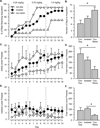The effects of social learning on the acquisition of cocaine self-administration
- PMID: 24878249
- PMCID: PMC4102004
- DOI: 10.1016/j.drugalcdep.2014.04.025
The effects of social learning on the acquisition of cocaine self-administration
Abstract
Background: Social learning models of substance use propose that drug-use behaviors are learned by observing and mimicking the behavior of others. The aim of this study was to examine the acquisition of cocaine self-administration in three groups of experimentally naïve rats: rats that were tested in isolation, rats that were tested in the presence of another rat that had access to cocaine and had previously been trained to self-administer cocaine, and rats that were tested in the presence of another rat that did not have access to cocaine.
Methods: Male rats were reared in isolated or pair-housed conditions and implanted with intravenous catheters. Pair-housed rats were then assigned to drug-experienced or drug-naïve conditions. In the drug-experienced condition, one rat of each pair was trained to self-administer cocaine in isolation before the reintroduction of its partner. In the drug-naïve condition, one rat of each pair did not have access to cocaine for the duration of the study. For each group, the acquisition of cocaine self-administration was measured over 15 days in rats with access to cocaine but no prior operant training.
Results: Rats tested with a drug-experienced partner were faster to acquire cocaine self-administration and emitted more active lever presses than rats tested with a cocaine-naïve partner. Data for the isolated control group fell between the other two groups on these measures.
Conclusion: These data indicate that the acquisition of cocaine self-administration can either be facilitated or inhibited by social contact. Collectively, these results support a social learning model of substance use.
Keywords: Cocaine; Rat; Self-administration; Social; Social learning.
Copyright © 2014 Elsevier Ireland Ltd. All rights reserved.
Conflict of interest statement
Conflict of Interest
The authors have no financial conflicts of interest in regard to this research.
Figures




Similar articles
-
Peer influences on drug self-administration: an econometric analysis in socially housed rats.Behav Pharmacol. 2013 Apr;24(2):114-23. doi: 10.1097/FBP.0b013e32835f1719. Behav Pharmacol. 2013. PMID: 23412112 Free PMC article.
-
Cocaine self-administration in social dyads using custom-built operant conditioning chambers.J Neurosci Methods. 2014 Oct 30;236:11-8. doi: 10.1016/j.jneumeth.2014.07.024. Epub 2014 Aug 7. J Neurosci Methods. 2014. PMID: 25109902 Free PMC article.
-
Peer influences on drug self-administration: social facilitation and social inhibition of cocaine intake in male rats.Psychopharmacology (Berl). 2012 Nov;224(1):81-90. doi: 10.1007/s00213-012-2737-6. Epub 2012 May 16. Psychopharmacology (Berl). 2012. PMID: 22588251 Free PMC article.
-
The effects of social contact on cocaine intake under extended-access conditions in male rats.Exp Clin Psychopharmacol. 2016 Aug;24(4):285-96. doi: 10.1037/pha0000078. Exp Clin Psychopharmacol. 2016. PMID: 27454676 Free PMC article.
-
Nonhuman primate models of social behavior and cocaine abuse.Psychopharmacology (Berl). 2012 Nov;224(1):57-67. doi: 10.1007/s00213-012-2843-5. Epub 2012 Aug 16. Psychopharmacology (Berl). 2012. PMID: 22895674 Free PMC article. Review.
Cited by
-
Social Contact Reinforces Cocaine Self-Administration in Young Adult Male Rats: The Role of Social Reinforcement in Vulnerability to Drug Use.Front Behav Neurosci. 2021 Oct 29;15:771114. doi: 10.3389/fnbeh.2021.771114. eCollection 2021. Front Behav Neurosci. 2021. PMID: 34776897 Free PMC article.
-
Self-administration acquisition latency predicts locomotor sensitivity to cocaine in male rats.Behav Brain Res. 2024 Sep 13;473:115170. doi: 10.1016/j.bbr.2024.115170. Epub 2024 Jul 29. Behav Brain Res. 2024. PMID: 39084564
-
Long-Term Behavioral Effects of Post-weaning Social Isolation in Males and Females.Front Behav Neurosci. 2019 Apr 11;13:66. doi: 10.3389/fnbeh.2019.00066. eCollection 2019. Front Behav Neurosci. 2019. PMID: 31031604 Free PMC article.
-
Peer presence and familiarity as key factors to reduce cocaine intake in both rats and humans: an effect mediated by the subthalamic nucleus.Psychopharmacology (Berl). 2022 Apr;239(4):1097-1113. doi: 10.1007/s00213-021-06033-0. Epub 2022 Jan 11. Psychopharmacology (Berl). 2022. PMID: 35013763
-
HIV-1 proteins dysregulate motivational processes and dopamine circuitry.Sci Rep. 2018 May 18;8(1):7869. doi: 10.1038/s41598-018-25109-0. Sci Rep. 2018. PMID: 29777165 Free PMC article.
References
-
- Aisner R, Terkel J. Ontogeny of pine cone opening behavior in the black rat, Rattus rattus. Anim. Behav. 1992;44:327–336.
-
- Andrews JA, Hops H. The influence of peers on substance abuse. In: Scheier LM, editor. Handbook of Drug Use Etiology: Theory, Methods, and Empirical Findings. Washington DC: American Psychological Association; 2010. pp. 403–420.
-
- Badiani A. Substance-specific environmental influences on drug use and drug preference in animals and humans. Curr. Opin. Neurobiol. 2013;23:588–596. - PubMed
-
- Bahi A. Increased anxiety, voluntary alcohol consumption and ethanol-induced place preference in mice following chronic psychosocial stress. Stress. 2013;16:441–451. - PubMed
-
- Bahr SJ, Hoffmann JP, Yang X. Parental and peer influences on the risk of adolescent drug use. J. Prim. Prev. 2005;26:529–551. - PubMed
Publication types
MeSH terms
Substances
Grants and funding
LinkOut - more resources
Full Text Sources
Other Literature Sources
Medical

